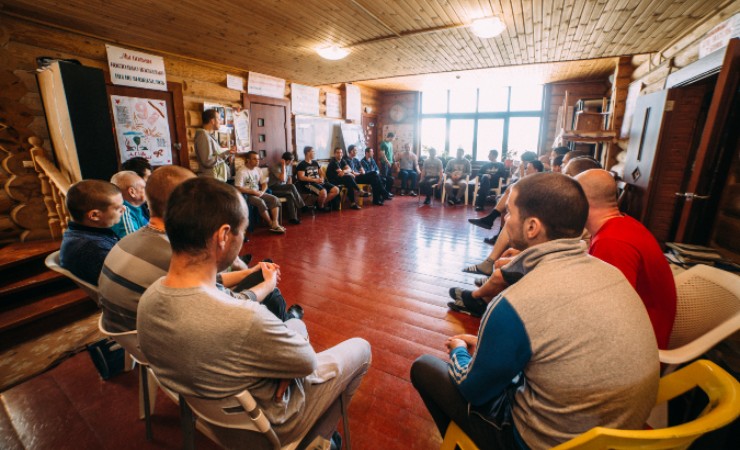What Ethnographers Have Learned from People Who Use Drugs

In color and consistency, black tar heroin is often compared to a Tootsie Roll. To become runny enough to pass through the point of a needle, a pellet of black tar must be heated in water to near boiling. After the drug has been injected, the syringes must be vigorously flushed to prevent the caramel-like residue from crystallizing.
In the late 1990s and early 2000s, two researchers methodically recorded these details while trying to explain a lingering puzzle of the AIDS epidemic: why people who use injection drugs west of the Mississippi River had lower rates of HIV than similar individuals elsewhere. Their observations eventually formed the basis of a 2003 paper, which noted that from Houston, to Los Angeles, to Seattle, the majority of available heroin was black tar, rather than the powder form common on the East Coast. The paper’s authors hypothesized that, among other things, the boiling of water and flushing of needles reduced the probability of transmitting HIV through shared equipment.
These observations and hypotheses were possible because the researchers, Philippe Bourgois and Dan Ciccarone, had immersed themselves among people who use heroin. In doing so, they were practicing ethnography, a research approach that seeks to understand how people think and behave in their natural environments through observation, interviews, and open-ended survey questions. Ethnographic research is conducted in a range of fields, including substance use and addiction. As the opioid epidemic stretches into a third decade and drug overdose deaths in the United States top 100,000 per year, some social scientists say this approach has taken on new urgency.
Ryan McNeil, an assistant professor at the Yale School of Medicine, says that past public health crises have underscored the need for a fine-grained understanding of the forces that drive risk and harm. Talking with and observing people — the methods of ethnographers — can yield precisely this kind of information, as can other types of research that center the lived experiences of people at risk.

Yet ethnographers tend to view themselves as underdogs, crowded out of funding and influence. Large-scale surveys, in which thousands of people submit answers to the same set of questions, are thought better able to represent large heterogenous populations. And randomized controlled trials, such as those that test the effectiveness of treatments for substance use, have long been described as the gold standard for research examining cause and effect, and championed for their potential to reduce bias. By contrast, data gleaned through in-depth unstructured interviews with a small number of people can be dismissed as anecdotal.
Ciccarone, now a professor and public health researcher at the University of California, San Francisco, says he understands the appeal of quantitative and lab-based research methods, but he thinks that researchers and policymakers tend to overestimate what these approaches can prove. “In the drug world, it’s a false god — that somehow we’re going to figure out the right chemical, the right enzyme pathway, that all the answers are going to be solved through a hard, disciplined version of science,” he said.
There are some indications that the old views are shifting as ethnographic studies have brought the experiences of people who use drugs to the forefront, and as more public health officials and policymakers have come to consider substance use a matter of public health rather than criminal deviance. Long associated with work where nuanced conclusions did not always align with the U.S. government’s historical war on drugs, substance use ethnographers are testing how amenable the country is to learning about, and even from, the people it once punished.
In a June 1971 press conference, then-President Richard Nixon announced that drug abuse was “public enemy number one,” marking the beginning of the nation’s extended war on drugs, a decades-long policy approach characterized by harsh prison sentences and an emphasis on abstinence. The National Institute on Drug Abuse, the primary federal agency for funding research on drug use, was established a few years later. Ethnographic methods have always been part of the research mix, but for years, social scientists who focused on the experience of people who use drugs failed to garner much attention, says Ricky Bluthenthal, associate dean for social justice at University of Southern California’s Keck School of Medicine.
This began to change in the 1980s with the rise of crack cocaine and the emergence of HIV/AIDS. Both epidemics spread rapidly and fed into broader concerns about urban decline and safety. But a growing body of ethnographic research undermined the case for harsh anti-drug laws. Early work with people who use intravenous drugs, for example, suggested that syringe distribution might help drive down HIV transmission — a finding that was later confirmed by laboratory analysis. Some public health professionals began to embrace these and other findings that pointed to the benefits of harm reduction, an approach focused on limiting the damage done by drugs rather than trying to eliminate their use through abstinence and criminalization. Even so, large swaths of the U.S. population viewed syringe distribution as an implicit endorsement of drug use and, therefore, untenable.
Bluthenthal wrote his 1998 dissertation on racial disparities in HIV rates among people who use intravenous drugs. At the time, he says, ethnography was viewed skeptically in part because people who used drugs were viewed by society, and even by some researchers, as unreliable. Moreover, concerns about the validity of ethnographic research lingered. “It wouldn’t be unusual,” he explained, “for some epidemiologist to say, ‘Oh, well, this study doesn’t have a probability-based sample, and they’re only talking to 40 people, so it’s both not rigorous and not generalizable, so what’s the point?’”
In recent years, public attitudes toward people who use drugs have started to shift, with politicians and policymakers increasingly calling for drug use to be treated as a matter of public health, not crime. Some experts have attributed the shift to the country’s underlying racism and racial bias. Crack was widely viewed as a drug used by Black people in urban areas, but the opioid epidemic struck White areas first. In a webinar hosted last year by the Drug Policy Alliance, Chinazo Cunningham, a physician and researcher at Albert Einstein College of Medicine, said she was appreciative of the more compassionate approach now being taken to help people with opioid use disorder. But, she added, “the way in which we got to that narrative is very bittersweet and problematic.”
In 2020, overdose mortality rates for Black people exceeded those of White people for the first time since the start of the opioid epidemic, and the total number of overdose deaths in the United States has continued to skyrocket. Support for drug research writ large has grown, too, though only slightly. For the 2003 fiscal year, NIDA’s proposed budget was about $968 million — about $1.5 billion in today’s dollars. President Biden’s proposed budget for the 2023 fiscal year calls for more than $1.8 billion in funding.
It is difficult to say how much of this is bound for ethnography. The National Institutes of Health, in which NIDA is housed, does not specifically track spending on ethnographic projects. A searchable database currently lists 2,863 projects for which NIDA is the lead agency; of these, 28 have project descriptions that contain the word “ethnographic,” though a spokesperson said that this may not capture all projects related to ethnographic research. (Every researcher interviewed for this story has been a part of at least one NIDA-funded study.)
Carlos Blanco, director of NIDA’s Division of Epidemiology, Services and Prevention Research, was a professor of psychiatry at Columbia University before coming to NIDA and has been on grant teams pursuing both ethnographic and epidemiological research. In an interview with Undark, he said that work centered on the lived experience of people who use drugs has been part of NIDA’s approach since the agency’s inception, but agreed that there is now a recognition of the need for a more holistic research strategy. Early in his career, biologists and social scientists tended to be more siloed in their work.
“I think over time there has been a recognition in the field that having silos is not very useful,” he said.
As views towards people who use drugs have shifted, public health policies rooted in harm reduction have popped up across the United States. As of 2021, syringe exchange programs, which allow people who use drugs to trade in used needles for sterile ones, were permitted in 39 states and the District of Columbia. Last fall, the country’s first two sanctioned safe injection sites, at which people can take illicit drugs while staff monitor them for signs of an overdose, opened in New York City.
Research centered on the experience of people who use drugs has helped inform these initiatives. The aforementioned research into IV drug use provided evidence to support needle exchange programs. And findings from studies using ethnographic methods have prompted researchers to recommend better access to naloxone, a drug now widely used to reverse potentially fatal overdoses. Connecticut and Nevada cited the Forecast, or Fentanyl Overdose Reduction Checking Analysis study, which included interviews with more than 300 people who use drugs, when introducing programs to distribute strips that detect fentanyl. A synthetic opioid that can be 50 times more potent than heroin, fentanyl has become pervasive in the nation’s drug supply and has been tied to an increase in overdose deaths.
Ethnographers are quick to credit the contributions of people who use drugs in shaping safe use practices. “A huge part of harm reduction is the fact that people who use drugs should not be left out of the conversation, should not be left out of the decision-making progress. They are an integral part of services and programs being successful” said Shana Harris, a cultural and medical anthropologist at the University of Central Florida and the vice chair of the Society for Medical Anthropology’s Alcohol, Drugs and Tobacco Study Group. “There is an absolute need to not leave them out of trying to better understand what’s going on.”
For some ethnographic researchers, this means not simply recording the experiences of people who use drugs, but incorporating them into the research process. A recent paper co-authored by McNeil, from the Yale School of Medicine, was built around interviews at a supervised drug consumption site and relied in part on peer researchers who “lived in the neighborhood, had lived experience of criminalized drug use, and were trained in research.” Structuring research in this way, McNeil said, helps ensure that research findings adequately reflect the fast-changing reality on the street. This is especially important as the increasing presence of fentanyl makes the illicit drug supply more lethal.
In a statement released in March about the Biden administration’s response to the opioid epidemic, the White House noted that it was “including the input of people who use drugs in designing harm reduction interventions,” and that it would be consulting “a steering committee made up entirely of people with lived experience.”
As some political obstacles begin to fade away, ethnographic findings may continue to challenge the status quo. One paper from 2020 examined the “protective effect of trusted dealers” in the context of the opioid crisis. Interviews with people who use drugs in Providence, Rhode Island, revealed that, for many who had long relationships with their dealers, this relationship was a way for them to use safely amid the increasing presence of fentanyl. One woman reported that her drug dealer saw a story on the news about someone who suffered a non-fatal overdose. He realized that the person was one of his clients, and that the heroin he was selling was tainted with fentanyl, so he called the woman to tell her to throw away her drugs and offered to replace them at a discount. Law enforcement has long arrested low-level drug dealers in the hope they will divulge information about larger suppliers, but the research suggested that this tactic could increase overdose deaths, by driving people with addiction to buy from unfamiliar sources.
McNeil, who has written about the role of drug dealers in harm reduction, acknowledged that deeply ingrained beliefs about dealers’ predatory nature stood in the way of incorporating them into public health efforts to reduce overdoses. Still, as McNeil sees it, this is no reason for research to shy away from probing drug dealers’ role — for better and worse — in the drug epidemic. Ethnography, long characterized as a lower tier of evidence in studying drug use, can find things other approaches miss.




















































































